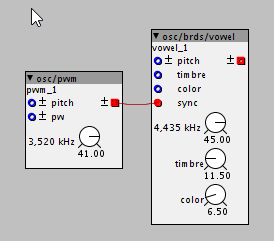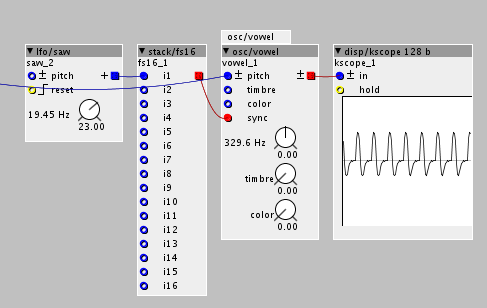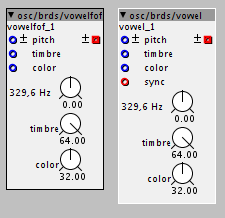
Whatever i insert into sync ,it has no effect.
What is wrong?
How to sync braids vowel?
Hm..
By looking at the code, I am not sure how the inlet should work, with the inlet[0].
Using s-rate inlet like that, inlet[o] is only 1/16 of a srate signal. But I dunno, its hard to tell what is going on behind the curtains with the braids modules as everything is not inside the objects as like most of the other objects.
same here, sync does not work.
I tried looking in the brds_digital.h file, that actually holds the oscillator data and I cant really make a lot of sense of it atm. Think I need to look at it a few time before understanding what it really does, ita a bit different than the good ole regular Axo objects.
But nice to know where the actual code for the braids objects are 
I tried something like this using an LFO instead, cause the inlet[0] is actually a krate signal...
But it doesnt work, sorry.

incorrect, it is an audio buffer , processed at 'audio rate'
the code is:
osc.Render(&inlet_sync[0],&outlet_wave[0],BUFSIZE,0);the & means it has access to the entire sync audio buffer
the reason it doesn't 'work' is much more mundane 
vowel does not support sync'ing...because the braids eurorack modules does not support sync for vowel, only for some oscillators.
why is sync an sync inlet if its not used?
because the interface underlying braids api is the same for all oscillators, so the objects where basically created from one 'template', we didn't go thru every braids oscillator to see what was used, what was not.
so really we should go thru the oscillators and remove those that don't support sync.
(but i don't have time to do this, as it involves go thru all the braids source code, checking, and then testing it doesn't break anything  )
)

there are two versions vowel and vowelfof are they different ?
and would it be hard to code a fm input?
Ah okay, from what I knew, it looked like a regular k-rate signal, like any other stacked k-rate signal.
yes, they are different algorithms (and so code) in braids.
you can see the MI code here
fm input hard?
if the underlying algo does not support FM, then yes it would likely be non-trivial.
but you never know without digging deeper into the MI code.
the inputs you see generally reflect how they are in the MI code, so if they were k-rate they were represented as k-rate, if audio, then they were presented as audio - we tried to 'wrap' the code as little as possible.
Johannes, took a slightly different approach to braids to the approach I took with the other MI modules.
as with braids he was able to pull out the individual algos into different objects.
(because if you look at the MI code, you'll see they neatly have different RenderX functions)
with the other module (e.g. clouds/elements) the code was not as clear cut, so it made more sense for me to keep them more like the eurorack module, so one module with different 'modes'
